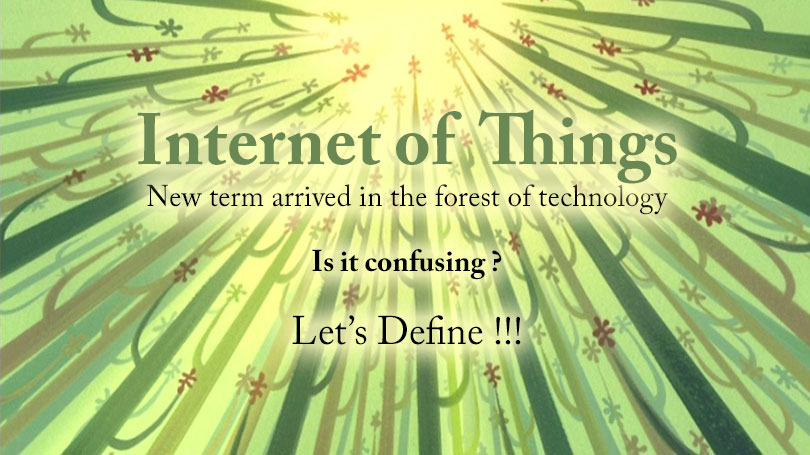Being an IoT domain based startup, it’s customary that we inaugurate our blog with an article based on it. So here, I am putting forward our views on IoT and IoE wink! ; )
Preface
We, oftenly, come across an issue where a majority of people confuse years old technical terms called DAQ, M2M and SCADA with a newly introduced, red hot, in trend concept called Internet of Things and Internet of Everything, abbreviated as IoT and IoE, respectively. Even those who are in the industries related to these domains either are confused or have misconceptions about the terms. Also, there is a confusion between “thing” and “everything”. In this article, I am only going to explain the differences between DAQ, M2M, SCADA and IoT. Rest will be discussed in the next article. Through this article, I am trying to impose a clear idea about these terminologies and am very sure that after reading this article, you will no longer be in any state of confusion.
Introduction
Introduction of IoT and IoE causes identity crises for pre-existing, well defined terminologies. Let’s apprise how this happens. To start with, I will define pre-existing terminologies first, namely DAQ, SCADA and M2M.
DAQ (Data Acquisition)
Years ago, people covered long distances with equipment to take record of readings of various parts of hardcore machineries in order to smoothen overall maintenance and operation. Think of such a hard work on Indian railways, as an example, whose network is spread across length and breadth of the country and is also one of the world’s largest railway network.
We all have witnessed the advancement in technology toward automating any kind of maintainable and operational tasks and fortunately, it’s a very relaxing gift for those hard working people as initial beneficiaries. All this started from DAQ. Data acquisition, as mentioned in world’s largest knowledge base resource, Wikipedia, is the “process of sampling signals that measure real world physical conditions and converting the resulting samples into digital numeric values that can be manipulated by a computer”. At the advent of DAQ, communication protocols were not there (or were proprietary) and so the computers were not talking to each other and were responsible to take all the predefined actions against the acquired data locally. In some cases, they used a specially designed back-up mainframe system to communicate with each other which were costly.
SCADA (Supervisory control and Data Acquisition)
The computers, acquiring numerical values from various sensors, are used to take real time predefined actions against that data. After proper manipulation of communication protocol, experts from all over start connecting these local nodes over network and that emerged as SCADA and Radio Telemetry as a combined system where all the radio units were monitored from Supervisory stations. Gradually, all the remote units, connected together, started talking over LAN initiating Machine to Machine communication (M2M). This created a line between all previous developments of this kind of automation and put a milestone becoming second generation by itself and making first the former one. Till this time, data was not stored and actions against acquired data took place at real time and data was dumped. Some systems also stored the data for some time but didn’t utilize it.
M2M (Machine to Machine Communication)
M2M really comes into play when technology was no more a problem to initiate communication between different types of machines. Now, embedded systems were able to communicate not only through computers and mobile devices but also from oven, refrigerators and air conditioners. At this stage, they started practising data storage and use that data to calculate and analyse many meaningful information and useful ratios which help to view overall picture from business or operational point of views and generate meaningful reports quarterly, half yearly or yearly like a power plant’s maintenance and operation report, as an example. Till this stage, very important IT departments like CRM, ERP were far away from this kind 0f automation and only networking and application/database administration were playing a very little role. At this stage, technology was used in industries only and was not so mature to be adopted in public domains. Now, what is IoT or IoE and how is it different from pre-existing terminologies like DAQ, SCADA or M2M?
Internet of Thing or Everything
Internet of (Every)thing is responsible for availing these technologies to public domain with cheaper price, better approach and meaningful utilities and for doing so, it took help from other IT domains which were ignored before like CRM, ERP etcetera . It connects almost every device calling them “Thing” or “Everything”. Here data is collected, analysed and not only necessary but also smart actions are taken to make life easier and comfortable. Every available communication protocols whether it’s short ranged like Infrared, Bluetooth or Wi-fi or long ranged like Internet is used, SMS are sent and main focus is toward making a human-less smart system in which large sensor network communicate with each other making a task force to capture every moment of meaningful data even from a single device, place or living being like us and take actions. The system is so powerful that on the basis of existing acquired data it can predicts many meaningful information that can be used in near future. To have such a huge system more nodes were needed and to communicate more IPs, IP6 (or LowPAN) was introduced and to deal with huge amount of data produced BigDATA. Rest all the big future analysis of hugeness of such an intelligent system is already populated over internet to study.
Conclusion
It is to be noted that these systems are not separate from one another but are just the next generation of former one and are evolved according to the availability of technology of the time.









